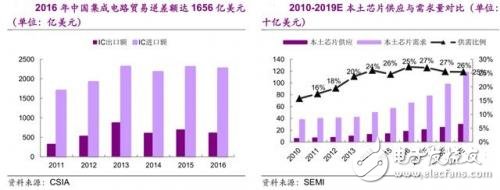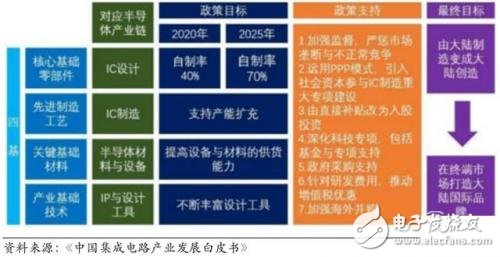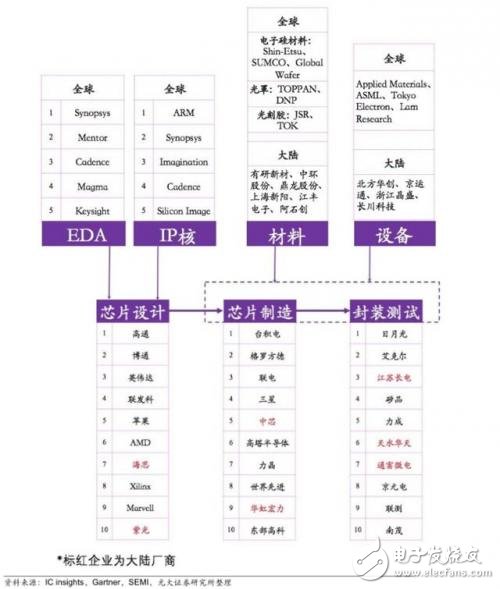The self-sufficiency rate of mainland chips is around 25%. With the national policy to promote the concentration of talents and funds to the semiconductor industry, China's domestic wafer production line has entered a period of high development since 2016. At present, 17 of the 22 fabs under construction in China will be mass-produced from the end of 2017 to 2018, with an additional investment of more than 600 billion yuan.
This article is from the mainland foundry industry report of Everbright Securities, from the current semiconductor industry transfer node to analyze the market opportunities and growth paths of mainland wafer foundries.
Six hundred billion investment in the opportunity period, the local semiconductor counterattackTime node: the third transfer of the semiconductor industry

â–² Semiconductor industry historical migration path
Semiconductors are known as the jewel of the national industry, the "heart" of the information industry.
The semiconductor industry originated in the United States, and the United States still has an absolute dominant position in the design of semiconductor products in the IDM model (from design, manufacturing, packaging testing, and investment to the consumer market) and vertical division of labor, while memory and wafers Heavy assets such as foundry and packaging and testing, and relatively low added value are gradually moving out.
As semiconductors are highly intensive in technology and capital, only major opportunities such as downstream terminal demand replacement will come, and emerging regions will have the opportunity to surpass and promote industrial chain migration through technology introduction and labor cost advantage.
Semiconductor has two industrial shifts in the era of large computer and PC. It is currently the next round of terminal demand for IoT (Internet of Things), creating opportunities for the rise of the mainland semiconductor industry and providing a time window for technology accumulation.
Everbright Securities believes that the semiconductor market will continue to be dominated by the increase in silicon content in smartphones in the next five years, and emerging areas such as automotive electronics and the Internet of Things are high-growth highlights. Under the support of national policy funds, the mainland semiconductor industry has become the third migration site of the semiconductor industry through its technology accumulation and early layout.
Local status: IC self-sufficiency rate increases
â–²The demand in the domestic downstream market is strong, and the self-sufficiency rate of IC is increasing.
China is the world's largest semiconductor consumer market, and the global share of semiconductor demand has climbed from 7% in 2000 to 42% in 2016, becoming the growth engine of the global semiconductor market.
However, the development of the mainland semiconductor industry does not match its huge market demand, and IC still relies heavily on imports. According to SEMI statistics, the self-sufficiency rate of local chips in 2016 was only 25%, and the self-sufficiency rate is still less than 30% in the next three years. There is still considerable room for improvement in domestic IC self-sufficiency rate.
Trend: The policy is beneficial to the three major segments

â–²China's semiconductor industry policy objectives and support
In order to avoid excessive dependence on imports by the mainland IC industry, the Chinese government has upgraded the semiconductor industry to a national strategic level and formulated clear plans for design, manufacturing, and testing.
The first phase of the National Integrated Circuit Industry Investment Fund (Big Fund) raised RMB 138.72 billion. As of September 2017, more than 55 investments have been made, and the committed investment amount has reached 100.3 billion yuan. The second phase of fundraising is in the pipeline. .
At the same time, the local integrated circuit industry investment fund (including preparation for construction), which was instigated by the “big fundâ€, reached 514.5 billion yuan, and the total fund size reached 653.1 billion yuan, guiding the capacity building and R&D process of the Chinese semiconductor industry to accelerate, and the production resources were accelerated. Ultimately achieve competitiveness.

â–² Leading manufacturers in all segments of the global semiconductor industry chain
FTTH Fiber Optical Fast Connectors
Fiber optic fast connector designed for FTTH. It is a new generation of fiber connector used in assembly. It can provide open flow and precast type, which optical and mechanical specification meets the standard optical fiber connector. It is designed for high quality and high eddiciency for installation, the structure of crimping position is a unique design. The hotest products are SC/APC Fast Connectors and SC/UPC Fast Connectors.

FTTH Fiber Optical Fast Connectors,FTTH SC/UPC Fast Connectors,SC/APC Fast Connectors,LC/APC SM Fast Connectors
NINGBO YULIANG TELECOM MUNICATIONS EQUIPMENT CO.,LTD. , https://www.yltelecom.com